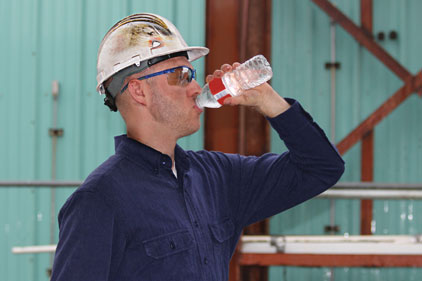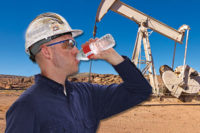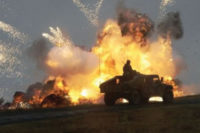Release the Heat
Breathable FR PPE worn in hot environments works to help alleviate heat-related risks

“Among the workplaces with which I am most familiar, clearly high environmental heat and clothing requirements are the biggest problems. The environmental heat comes in the form of high workplace temperatures and humidity, and on occasion significant amounts of radiant heat. A person’s capacity for balancing the heat stress by evaporative cooling is truly remarkable. When special purpose clothing is worn to prevent burns or chemical contamination of the skin, the rate of evaporative cooling is greatly reduced.”
When PPE poses a problem
Numerous studies have documented that strenuous firefighting activities can lead to near maximum heart rates and dangerously raised body core temperatures, both remaining elevated for a prolonged period of time. When a person engages in elevated levels of physical activity, the body increases the metabolic rate and thus the rate of heat production. The body must then use additional resources to remove the additional heat produced in order to keep the internal temperature at a healthy level. Extreme heat and exertion are especially dangerous when coupled with protective clothing that encapsulates sweat rather than allowing it to evaporate and provide evaporative cooling.
Clearly, PPE is vital in protecting workers. Generally, garments are layered in order for PPE to provide the necessary thermal and flame protection, resulting in bulky clothing systems that are heavy and restrict heat dissipation which can lead to heat strokes, heart attacks and death. Most of today’s clothing systems include wearing undergarments not only to provide thermal protection but also to protect from an outer layer’s synthetic materials, which are known to melt and adhere to human skin when subjected to extreme heat. If an FR protective garment also has insulating properties, then heat stress dangers are further compounded.
Fortunately, new technologies and proprietary fiber combinations and fabrics now address this concern by allowing the dissipation of metabolic heat, while providing necessary thermal and flame protection in a single lightweight, breathable layer. These fabrics can also be inherently fireproof, comfortable, durable and machine-washable. Generally, most fabrics are manufactured in both twill and knit blends, meaning garments made from these technologically advanced fabrics provide the wearer with proven inner and outer layer protection.
It is important that a manufacturer verify that their fabric truly does allow the release of body heat and moisture into the environment. This can be done by testing fabric according to ASTM F1868, which measures total heat loss (THL). Because the sweating hot plate does not consider effects such as insulating air layers, garment design and fit, the THL value represents the highest possible amount of heat that can be transferred through a material system for a given set of environmental conditions without active cooling or ventilation.
THL measurements per ASTM F1868 are required by several National Fire Protection Association (NFPA) standards: NFPA 1971, NFPA 1951, NFPA 1977, NFPA 1994, and NFPA 1999. As examples, the THL requirement for NFPA 1977 is a value greater than 450 W/m2, and for NFPA 1971 it is a value greater than 205 W/m2. These numbers are difficult to achieve if a fabric does not allow heat and moisture to escape into the environment, but they are even more difficult, or impossible, to achieve if the garment system consists of multiple layers. Some of the new technologies and fiber combinations can provide THL values above and beyond the minimum required THL values, as both twill and knits.
Practice prevention
On a normal hot summer day, a few simple precautions can prevent heat-related illnesses. According to Dr. Bernard:
“The most frequent illness among workers exposed to heat stress through environmental conditions and/or clothing requirements is heat exhaustion, which is most likely due to dehydration. Some workplaces will also report frequent occurrence of muscle cramps. To reduce the risk of heat disorders, a strong emphasis is placed on heat-stress hygiene practices. These include self-limitation, adequate fluid replacement, eating a good, well-balanced diet, monitoring health status, and allowing for acclimation to the heat. The workers must be aware of what they can do to lower their individual risks for heat disorders, and the employer must do those things that are reasonable to encourage these practices. Often not considered is the fact that heat stress is associated with increased unsafe behaviors and the accidents and injuries that result.”
Workers at greater risk of heat stress include those who are 65 years of age or older, are overweight, have heart disease or high blood pressure, or take medications that may be affected by extreme heat. Prevention of heat stress in workers is important. Employers should provide training to workers so they understand what heat stress is, how it affects their health and safety, and how it can be prevented.
Flame-resistant garments made from the new fabrics also remain soft, flexible and intact after flame and thermal events — unlike aramid and nylon fibers that either embrittle and disintegrate or melt and drip within seconds of high heat exposure. Their protection against thermal and flame events allows for a lighter weight garment system to be worn while still providing significantly higher protection, burn-through resistance, durability and comfort.
More work is being done to demonstrate that new technology exists within the flame-resistant/PPE arena that can drive or mitigate skin temperature rise, regardless of how tough or hot the environment may be.
Looking for a reprint of this article?
From high-res PDFs to custom plaques, order your copy today!






